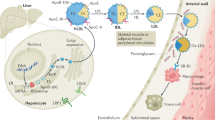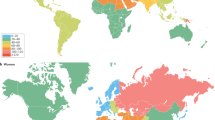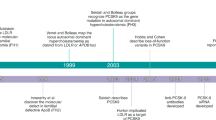Abstract
Conventionally, atherogenic dyslipidemias have been defined by elevated levels of triglyceride and/or LDL cholesterol. However, cholesterol and triglycerides are not metabolically and physically independent entities. Rather, they are constituents of the atherogenic apolipoprotein B (apoB) particles, which differ in their origin and their metabolic function. Moreover, the risk of vascular disease is not related to the plasma concentration of cholesterol or triglyceride per se, but to the number, composition and size of the apoB particles, within which the cholesterol and triglycerides are contained. After all, the entire apoB particle—rather than individual cholesterol or triglyceride molecules—enters and is trapped within the arterial wall, and this particle initiates and sustains the process that results in atherosclerosis. Accordingly, we suggest a change of name and focus from dyslipidemias to dyslipoproteinemias. Virtually all the atherogenic apoB dyslipoproteinemias can be specifically identified on the basis of plasma levels of cholesterol, triglyceride and apoB. Not only does this enable an accurate diagnosis in the individual, but the major familial dyslipoproteinemias can be identified as well. Here, we review the diagnostic algorithm for apoB dyslipoproteinemias and provide, for the first time, a treatment plan on the basis of a reduction of atherogenic lipoprotein particles rather than plasma lipids.
Key Points
-
The six major apolipoprotein B (apoB) dyslipoproteinemias can be specifically identified by their levels of total cholesterol, triglycerides and apoB
-
These dyslipoproteinemias can be discriminated owing to differences in the type of the apoB particle, the number of apoB particles and the composition of the apoB particles
-
The characteristic apoB phenotype of the major apoB dyslipoproteinemias is a product of their underlying pathophysiology
-
Atherogenic apoB particles—in particular, remnants and LDL particles—should be the primary target of therapy rather than plasma lipid levels
This is a preview of subscription content, access via your institution
Access options
Subscribe to this journal
Receive 12 print issues and online access
$209.00 per year
only $17.42 per issue
Buy this article
- Purchase on Springer Link
- Instant access to full article PDF
Prices may be subject to local taxes which are calculated during checkout




Similar content being viewed by others
References
Fredrickson, D. S., Levy, R. I. & Lees, R. S. Fat transport in lipoproteins—an integrated approach to mechanisms and disorders. N. Engl. J. Med. 276, 34–42 (1967).
Fredrickson, D. S., Levy, R. I. & Lees, R. S. Fat transport in lipoproteins—an integrated approach to mechanisms and disorders. N. Engl. J. Med. 276, 94–103 (1967).
Fredrickson, D. S., Levy, R. I. & Lees, R. S. Fat transport in lipoproteins—an integrated approach to mechanisms and disorders. N. Engl. J. Med. 276, 148–156 (1967).
Havel, J. H. & Kane, J. P. in The Metabolic and Molecular Bases of Inherited Disease (eds Scriver, C. R. et al.) 2705–2716 (McGraw-Hill, New York, 2001).
Elovson, J. et al. Plasma very low density lipoproteins contain a single molecule of apolipoprotein B. J. Lipid Res. 29, 1461–1473 (1988).
Cromwell, W. C. & Barringer, T. A. Low-density lipoprotein and apolipoprotein B: clinical use in patients with coronary heart disease. Curr. Cardiol. Rep. 11, 468–475 (2009).
Kane, J. P., Hardman, D. A. & Paulus, H. E. Heterogeneity of apolipoprotein B: isolation of a new species from human chylomicrons. Proc. Natl Acad. Sci. USA 77, 2465–2469 (1980).
Shen, M. M., Krauss, R. M., Lindgren, F. T. & Forte, T. M. Heterogeneity of serum low density lipoproteins in normal human subjects. J. Lipid Res. 22, 236–244 (1981).
Teng, B. et al. Composition and distribution of low density lipoprotein fractions in hyperapobetalipoproteinemia, normolipidemia and familial hypercholesterolemia. Proc. Natl Acad. Sci. USA 80, 6662–6666 (1983).
Packard, C. J. & Shepherd, J. Lipoprotein heterogeneity and apolipoprotein B metabolism. Arterioscler. Thromb. Vasc. Biol. 17, 3542–3556 (1997).
Durrington, P. N., Bolton, C. H. & Hartog, M. Serum and lipoprotein apolipoprotein B levels in normal subjects and patients with hyperlipoproteinemia. Clin. Chim. Acta 82, 151–160 (1978).
Sniderman, A., Vu, H. & Cianflone, K. The effect of moderate hypertriglyceridemia on the relation of plasma total and LDL apoB levels. Atherosclerosis 89, 109–116 (1991).
Garvey, W. T. et al. The effects of insulin resistance and type 2 diabetes mellitus on lipoprotein subclass particle size and concentration determined by nuclear magnetic resonance. Diabetes 52, 453–462 (2003).
Grundy, S. M. Statin trials and goals of cholesterol-lowering therapy. Circulation 97, 1436–1439 (1998).
Teng, B., Sniderman, A. D., Soutar, A. K. & Thompson, G. R. Metabolic basis of hyperapobetalipoproteinemia. Turnover of apolipoprotein B in low density lipoprotein and its precursors and subfractions compared with normal and familial hypercholesterolemia. J. Clin. Invest. 77, 663–672 (1986).
Mykkänen, L., Kuusisto, J., Haffner, S. M., Laakso, M. & Austin, M. A. LDL size and risk of coronary heart disease in elderly men and women. Arterioscler. Thromb. Vasc. Biol. 19, 2742–2748 (1999).
Stampfer, M. J. et al. A prospective study of triglyceride level, low-density lipoprotein particle diameter, and risk of myocardial infarction. JAMA 276, 882–888 (1996).
Gardner, C. D., Fortmann, S. P. & Krauss, R. M. Association of small low-density lipoprotein particles with the incidence of coronary artery disease in men and women. JAMA 276, 875–881 (1996).
Kamigaki, A. S. et al. Low density lipoprotein particle size and risk of early-onset myocardial infarction in women. Am. J. Epidemiol. 153, 939–945 (2001).
Austin, M. A. et al. Low-density lipoprotein particle size, triglycerides, and high-density lipoprotein cholesterol as risk factors for coronary heart disease in older Japanese-American men. Am. J. Cardiol. 86, 412–416 (2000).
Lamarche, B. et al. Small, dense low-density lipoprotein particles as a predictor of the risk of ischemic heart disease in men. Prospective results from the Québec Cardiovascular Study. Circulation 95, 69–75 (1997).
Williams, P. T. et al. Smallest LDL particles are most strongly related to coronary disease progression in men. Arterioscler. Thromb. Vasc. Biol. 23, 314–321 (2003).
Campos, H., Roederer, G. O., Lussier-Cacan, S., Davignon, J. & Krauss, R. M. Predominance of large LDL and reduced HDL2 cholesterol in normolipidemic men with coronary artery disease. Arterioscler. Thromb. Vasc. Biol. 15, 1043–1048 (1995).
Campos, H., Moye, L. A., Glasser, S. P., Stampfer, M. J. & Sacks, F. M. Low-density lipoprotein size, pravastatin treatment, and coronary events. JAMA 286, 1468–1474 (2001).
Nordestgaard, B. G. & Zilversmit, D. B. Comparison of arterial intimal clearances of LDL from diabetic and nondiabetic cholesterol-fed rabbits. Differences in intimal clearance explained by size differences. Arteriosclerosis 9, 176–183 (1989).
Björnheden, T., Babyi, A., Bondjers, G. & Wiklund, O. Accumulation of lipoprotein fractions and subfractions in the arterial wall, determined in an in vitro perfusion system. Atherosclerosis 123, 43–56 (1996).
Hurt-Camejo, E. et al. Differential uptake of proteoglycan-selected subfractions of low density lipoprotein by human macrophages. J. Lipid Res. 31, 1387–1398 (1990).
de Graaf, J. et al. Enhanced susceptibility to in vivo oxidation of the dense low density lipoprotein subfraction in healthy subjects. Arterioscler. Thromb. 11, 298–306 (1991).
Dejager, S., Bruckert, E. & Chapman, M. J. Dense low density lipoprotein subspecies with diminished oxidative resistance predominate in combined hyperlipidemia. J. Lipid Res. 34, 295–308 (1993).
Sniderman, A. D., Pedersen, T. & Kjekshus, J. Putting low-density lipoprotein at center stage in atherogenesis. Am. J. Cardiol. 79, 64–67 (1997).
Tabas, I., Williams, K. J. & Borén, J. Subendothelial lipoprotein retention as the initiating process in atherosclerosis: update and therapeutic implications. Circulation 116, 1832–1844 (2007).
de Graaf, J., Couture, P. & Sniderman, A. A diagnostic algorithm for the atherogenic apolipoprotein B dyslipoproteinemias. Nat. Clin. Pract. Endocrinol. Metab. 4, 608–618 (2008).
Adult Treatment Panel III. Third report of the National Cholesterol Education Program (NCEP) expert panel on detection, evaluation, and treatment of high blood cholesterol in adults final report. Circulation 106, 3143–3421 (2002).
Durrington, P. N. Hyperlipidaemia: Diagnosis and Management (Butterworth-Heinemann, Oxford, 2009).
Davidson, M. H., Toth, P. P. & Maki, K. C. (Eds) Therapeutic Lipidology (Humana Press, Totowa, New Jersey, 2007).
Ballantyne, C. M. Clinical Lipidology (Saunders Elsevier, Philadelphia, PA, 2009).
Sniderman, A. D., Zhang, X. J. & Cianflone, K. Governance of the concentration of plasma LDL: a reevaluation of the LDL receptor paradigm. Atherosclerosis 148, 215–229 (2000).
Duez, H. et al. Both intestinal and hepatic lipoprotein production are stimulated by an acute elevation of plasma free fatty acids in humans. Circulation 117, 2369–2376 (2008).
Lewis, G. F. Fatty acid regulation of very low density lipoprotein production. Curr. Opin. Lipidol. 8, 146–153 (1997).
Sniderman, A. D. & Cianflone, K. Substrate delivery as a determinant of hepatic apoB secretion. Arterioscler. Thromb. 13, 629–636 (1993).
Barter, P. J. et al. ApoB versus cholesterol in estimating cardiovascular risk and in guiding therapy: report of the thirty-person/ten-country panel. J. Intern. Med. 259, 247–258 (2006).
Goldberg, I. J. Lipoprotein lipase and lipolysis: central roles in lipoprotein metabolism and atherogenesis. J. Lipid Res. 37, 693–707 (1996).
Ewald, N., Hardt, P. D. & Kloer, H. U. Severe hypertriglyceridemia and pancreatitis: presentation and management. Curr. Opin. Lipidol. 20, 497–504 (2009).
Borba, E. F., Bonfá, E., Vinagre, C. G., Ramires, J. A. & Maranhã, R. C. Chylomicron metabolism is markedly altered in systemic lupus erythematosus. Arthritis Rheum. 43, 1033–1040 (2000).
Yeh, J. H., Chen, J. H. & Chiu, H. C. Plasmapheresis for hyperlipidemic pancreatitis. J. Clin. Apher. 18, 181–185 (2003).
Shirai, K. et al. Type 1 hyperlipoproteinemia caused by lipoprotein lipase defect in lipid-interface recognition was relieved by administration of medium-chain triglyceride. Metabolism 41, 1161–1164 (1992).
Rouis, M. et al. Therapeutic response to medium-chain triglycerides and omega-3 fatty acids in a patient with the familial chylomicronemia syndrome. Arterioscler. Thromb. Vasc. Biol. 17, 1400–1406 (1997).
Sullivan, D. R., Sanders, T. A., Trayner, I. M. & Thompson, G. R. Paradoxical elevation of LDL apoprotein B levels in hypertriglyceridaemic patients and normal subjects ingesting fish oil. Atherosclerosis 61, 129–134 (1986).
Cater, N. B., Heller, H. J. & Denke, M. A. Comparison of the effects of medium-chain triacylglycerols, palm oil, and high oleic acid sunflower oil on plasma triacylglycerol fatty acids and lipid and lipoprotein concentrations in humans. Am. J. Clin. Nutr. 65, 41–45 (1997).
Tsuang, W., Navaneethan, U., Ruiz, L. Palascak, J. B. & Gelrud, A. Hypertriglyceridemic pancreatitis: presentation and management. Am. J. Gastroenterol. 104, 984–991 (2009).
Marcovina, S. M. et al. International Federation of Clinical Chemistry standardization project for measurements of apolipoproteins A-I and B. IV. Comparability of apolipoprotein B values by use of International Reference Material. Clin. Chem. 40, 586–592 (1994).
Blom, D. J., O'Neill, F. H. & Marais, A. D. Screening for dysbetalipoproteinemia by plasma cholesterol and apolipoprotein B concentrations. Clin. Chem. 51, 904–907 (2005).
Sniderman, A. et al. Diagnosis of type III hyperlipoproteinemia from plasma total cholesterol, triglyceride, and apolipoprotein B. J. Clin. Lipidol. 1, 256–263 (2007).
Mahley, R. W., Huang, Y. & Rall, S. C. Jr. Pathogenesis of type III hyperlipoproteinemia (dysbetalipoproteinemia). Questions, quandries and paradoxes. J. Lipid Res. 40, 1933–1949 (1999).
Cohen, J. C., Vega, G. L. & Grundy, S. M. Hepatic lipase: new insights from genetic and metabolic studies. Curr. Opin. Lipidol. 10, 259–267 (1999).
Morganroth, J., Levy, R. I. & Fredrickson, D. S. The biochemical, clinical and genetic features of type III hyperlipoproteinemia. Ann. Intern. Med. 82, 158–174 (1975).
Blom, D. J., Byrnes, P., Jones, S. & Marais, A. D. Dysbetalipoproteinemia—clinical and pathophysiological features. S. Afr. Med. J. 92, 892–897 (2002).
Abbott, W. G. et al. Effect of a high-carbohydrate, low-saturated-fat diet on apolipoprotein B and triglyceride metabolism in Pima Indians. J. Clin. Invest. 86, 642–650 (1990).
Melish, J., Le, N. A., Ginsberg, H., Steinberg, D. & Brown, W. V. Dissociation of apoprotein B and triglyceride production in very low-density lipoproteins. Am. J. Physiol. 239, E354–E362 (1980).
Brunzell, J. D. et al. Plasma lipoproteins in familial combined hyperlipidaemia and monogenic hypertriglyceridaemia. J. Lipid Res. 24, 147–155 (1983).
Julien, P. et al. Dyslipidemias associated with heterozygous lipoprotein lipase mutations in the French-Canadian population. Hum. Mutat. Suppl. 1, S148–S153 (1998).
Keech, A. et al. Effects of long-term fenofibrate therapy on cardiovascular events in 9795 people with type 2 diabetes mellitus (the FIELD study): randomised controlled trial. Lancet 366, 1849–1861 (2005).
The ACCORD Study Group. Effects of combination lipid therapy in type 2 diabetes mellitus. N. Engl. J. Med. doi:10.1056/NEJMoa1001282.
Hogue, J. C. et al. Differential effect of fenofibrate and atovastatin on in vivo kinetics of apolipoproteins B-100 and B-48 in subjects with type 2 diabetes mellitus with marked hypertriglyceridemia. Metabolism 57, 246–254 (2008).
Goldstein, J. L. & Brown, M. S. in The Metabolic Basis of Inherited Disease (eds Scriver, C. R. et al.) 1210–1250 (McGraw-Hill Information Services Co., New York, 1989).
Soria, L. F. et al. Association between a specific apolipoprotein B mutation and familial defective apolipoprotein B-100. Proc. Natl Acad. Sci. USA 86, 587–591 (1989).
Gaw, A. et al. Overproduction of small very low density lipoproteins (Sf 20–60) in moderate hypercholesterolemia: relationships between apolipoprotein B kinetics and plasma lipoproteins. J. Lipid Res. 36, 158–171 (1995).
Sniderman, A. D. Differential response of cholesterol and particle measures of atherogenic lipoproteins to LDL-lowering therapy: implications for clinical practice. J. Clin. Lipidol. 2, 36–42 (2008).
Ladenson, P. W. et al. Use of the thyroid hormone analog eprotirome in statin-treated dyslipidemia. N. Engl. J. Med. 362, 906–916 (2010).
Cortner, J., Bennett, M. J., Le, N. A. & Coates, P. M. The effect of lovastatin on very-low-density lipoprotein B production by the liver in familial combined hyperlipidemia. J. Inherit. Metab. Dis. 16, 127–134 (1993).
Veerkamp, M. J., de Graaf, J., Hendriks, J. C., Demacker, P. N. & Stalenhoef, A. F. Nomogram to diagnose familial combined hyperlipidemia based on results of a 5-year follow-up study. Circulation 109, 2980–2985 (2004).
Wiesbauer, F. et al. Familial-combined hyperlipidaemia in very young myocardial infarction survivors (< or = 40 years of age). Eur. Heart J. 30, 1073–1079 (2009).
Sniderman, A. D., Scantlebury, T, & Cianflone, K. Hypertriglyceridemic hyperapoB: the unappreciated atherogenic dyslipoproteinemia in type 2 diabetes mellitus. Ann. Intern. Med. 135, 447–459 (2001).
Sniderman, A. D. in The Therapy of Atherogenic Dyslipoproteinaemias in Therapeutic Strategies in Lipid Disorders (ed. Tonkin, A. M.) 43–57 (Clinical Publishing, Oxford, 2009).
Gotto, A. M. Jr et al. Relation between baseline and on-treatment lipid parameters and first acute major coronary events in the Air force/Texas Coronary Atherosclerosis Prevention Study (AFCAPS/TexCAPS). Circulation 101, 477–484 (2000).
van Lennep, J. E. et al. Apolipoprotein concentrations during treatment and recurrent coronary artery disease events. Arterioscler. Thromb. Vasc. Biol. 20, 2408–2413 (2000).
Simes, R. J. et al. Relationship between lipid levels and clinical outcomes in the long-term intervention with pravastatin in the ischemic disease (LIPID) trial. To what extent is the reduction in coronary events with pravastatin explained by on-study lipid levels? Circulation 105, 1162–1169 (2002).
Otvos, J. D. et al. Low-density lipoprotein and high-density lipoprotein particle subclasses predict coronary events and are favorably changed by gemfibrozil therapy in the Veterans Affairs High-Desnity Lipoprotein Intervention Trial. Circulation 113, 1553–1555 (2006).
Hayward, R. A., Hofer T. P. & Vijan, S. Narrative Review: Lack of evidence for recommended low-density lipoprotein treatment targets: a solvable problem. Ann. Intern. Med. 145, 520–530 (2006).
Pedersen, T. R. et al. Lipoprotein changes and reduction in the incidence of major coronary heart disease events in the Scandinavian Simvastatin Survival Study (4S). Circulation 97, 1453–1460 (1998).
Kastelein, J. J. et al. Lipids, apolipoproteins, and their ratios in relation to cardiovascular events with statin treatment. Circulation 117, 3002–3009 (2008).
Ray, K. K. et al. Prognostic utility of apoB/AI, total cholesterol/HDL, non-HDL cholesterol, or hs-CRP as predictors of clinical risk in patients receiving statin therapy after acute coronary syndromes: results from PROVE IT-TIMI 22. Arterioscler. Thromb. Vasc. Biol. 29, 424–430 (2009).
Brunzell, J. D. et al. Lipoprotein management in patients with cardiometabolic risk. Consensus statement from the American Diabetes Association and the American College of Cardiology Foundation. Diabetes Care 31, 811–822 (2008).
Contois, J. H. et al. Apolipoprotein B and cardiovascular disease risk: position statement from the AACC Lipoproteins and Vascular Diseases Division Working Groups on Best Practices. Clin. Chem. 55, 407–419 (2009).
Genest, J. et al. 2009 Canadian Cardiovascular Society/Canadian guidelines for the diagnosis and treatment of dyslipidemia and prevention of cardiovascular disease in the adult—2009 recommendations. Can. J. Cardiol. 25, 567–579 (2009).
Sibal, L., Neely, R. D., Jones, A. & Home, P. D. Friedewald equation underestimates low-density lipoprotein cholesterol at low concentrations in young people with and without type 1 diabetes. Diabet. Med. 27, 37–45 (2010).
Grundy, S. M. et al. Implications of recent clinical trials for the National Cholesterol Education Program Adult Treatment Panel III Guidelines. J. Am. Coll. Cardiol. 44, 720–732 (2004).
Contois, J. H. et al. Reference intervals for plasma apolipoprotein B determined with a standardized commercial immunoturbidimetric assay: results from the Framingham Offspring Study. Clin. Chem. 42, 515–523 (1996).
Bachorik, P. S., Lovejoy, K. L., Carroll, M. D. & Johnson, C. L. Apolipoprotein B and A1 distributions in the United States, 1988–1991: results of the National Health and Nutrition Examination Survey III (NHANES III). Clin. Chem. 43, 2364–2378 (1997).
Sniderman, A. D. & Kiss, R. S. The strengths and limitations of the apoB/apoA-1 ratio to predict the risk of vascular disease: a Hegelian analysis. Curr. Atheroscler. Rep. 9, 261–265 (2007).
Author information
Authors and Affiliations
Corresponding author
Ethics declarations
Competing interests
The authors declare no competing financial interests.
Rights and permissions
About this article
Cite this article
Sniderman, A., Couture, P. & de Graaf, J. Diagnosis and treatment of apolipoprotein B dyslipoproteinemias. Nat Rev Endocrinol 6, 335–346 (2010). https://doi.org/10.1038/nrendo.2010.50
Published:
Issue Date:
DOI: https://doi.org/10.1038/nrendo.2010.50
This article is cited by
-
Apolipoproteins in vascular biology and atherosclerotic disease
Nature Reviews Cardiology (2022)
-
A new phenotypic classification system for dyslipidemias based on the standard lipid panel
Lipids in Health and Disease (2021)
-
Sex differences in systemic metabolites at four life stages: cohort study with repeated metabolomics
BMC Medicine (2021)
-
Hypertriglyzeridämie verstehen
Der Kardiologe (2021)
-
Dyslipidemia: Contemporary Therapy Options in Terms of Worldwide Guidelines
Current Pharmacology Reports (2019)



